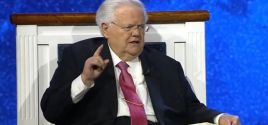How Government Solved the Health Care Crisis!YouTubeSep. 10, 2012 |
Popular 
'Woke' Google Fires 28 Employees Who Protested Gaza Genocide

Report: Blinken Sitting On Staff Recommendations to Sanction Israeli Military Units Linked to Killings or Rapes

America Last: House Bill Provides $26B for Israel, $61B for Ukraine and Zero to Secure U.S. Border

Bari Weiss' Free Speech Martyr Uri Berliner Wants FBI and Police to Spy on Pro-Palestine Activists

John Hagee Cheers Israel-Iran Battle as 'Gog and Magog War,' Will Lobby Congress Not to Deescalate
 Today, we are constantly being told, the United States faces a health care crisis. Medical costs are too high, and health insurance is out of reach of the poor. The cause of this crisis is never made very clear, but the cure is obvious to nearly everybody: government must step in to solve the problem. Eighty years ago, Americans were also told that their nation was facing a health care crisis. Then, however, the complaint was that medical costs were too low, and that health insurance was too accessible. But in that era, too, government stepped forward to solve the problem. And boy, did it solve it! In the late 19th and early 20th centuries, one of the primary sources of health care and health insurance for the working poor in Britain, Australia, and the United States was the fraternal society. Fraternal societies (called "friendly societies" in Britain and Australia) were voluntary mutual-aid associations. Their descendants survive among us today in the form of the Shriners, Elks, Masons, and similar organizations, but these no longer play the central role in American life they formerly did. As recently as 1920, over one-quarter of all adult Americans were members of fraternal societies. (The figure was still higher in Britain and Australia.) Fraternal societies were particularly popular among blacks and immigrants. (Indeed, Teddy Roosevelt's famous attack on "hyphenated Americans" was motivated in part by hostility to the immigrants' fraternal societies; he and other Progressives sought to "Americanize" immigrants by making them dependent for support on the democratic state, rather than on their own independent ethnic communities.) The principle behind the fraternal societies was simple. A group of working-class people would form an association (or join a local branch, or "lodge," of an existing association) and pay monthly fees into the association's treasury; individual members would then be able to draw on the pooled resources in time of need. The fraternal societies thus operated as a form of self-help insurance company. Turn-of-the-century America offered a dizzying array of fraternal societies to choose from. Some catered to a particular ethnic or religious group; others did not. Many offered entertainment and social life to their members, or engaged in community service. Some "fraternal" societies were run entirely by and for women. The kinds of services from which members could choose often varied as well, though the most commonly offered were life insurance, disability insurance, and "lodge practice." "Lodge practice" refers to an arrangement, reminiscent of today's HMOs, whereby a particular society or lodge would contract with a doctor to provide medical care to its members. The doctor received a regular salary on a retainer basis, rather than charging per item; members would pay a yearly fee and then call on the doctor's services as needed. If medical services were found unsatisfactory, the doctor would be penalized, and the contract might not be renewed. Lodge members reportedly enjoyed the degree of customer control this system afforded them. And the tendency to overuse the physician's services was kept in check by the fraternal society's own "self-policing"; lodge members who wanted to avoid future increases in premiums were motivated to make sure that their fellow members were not abusing the system... Source: http://www.freenation.org/a/f12l3.html Freedomain Radio is the largest and most popular philosophy show on the web - http://www.freedomainradio.com |



